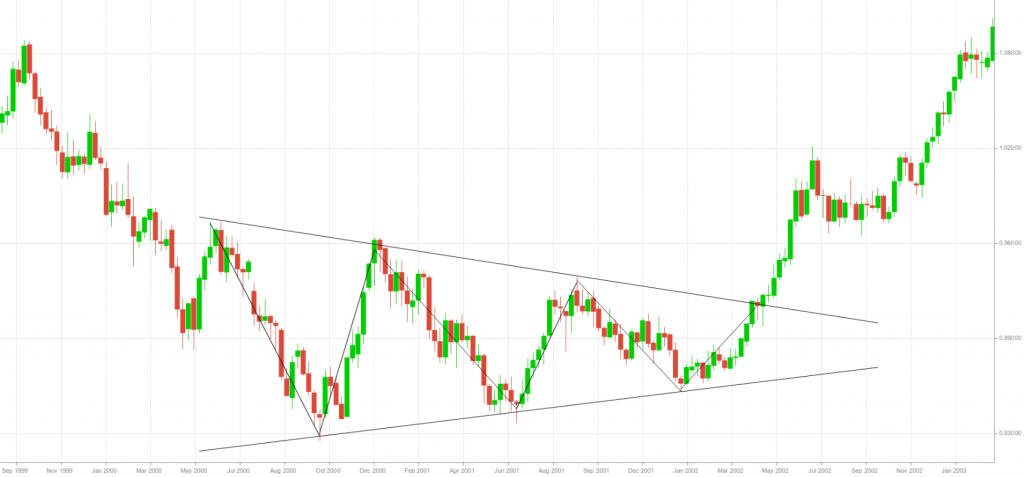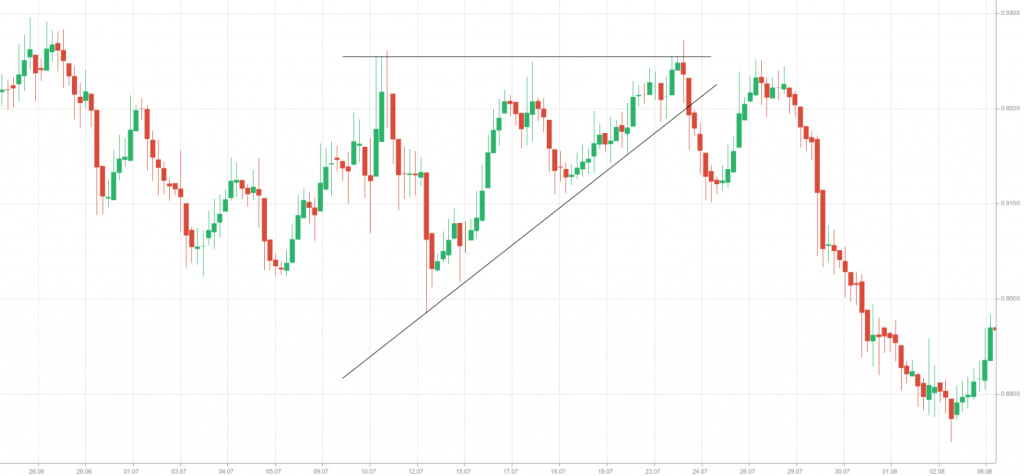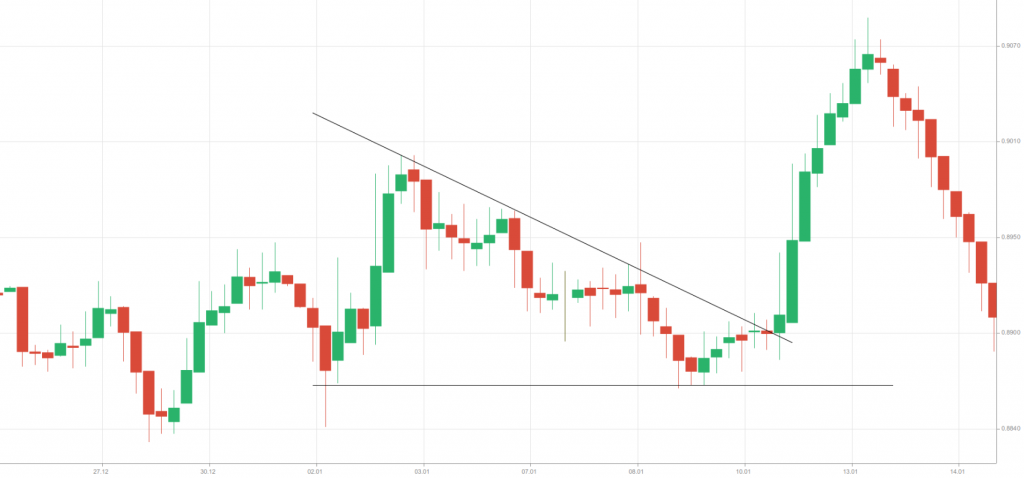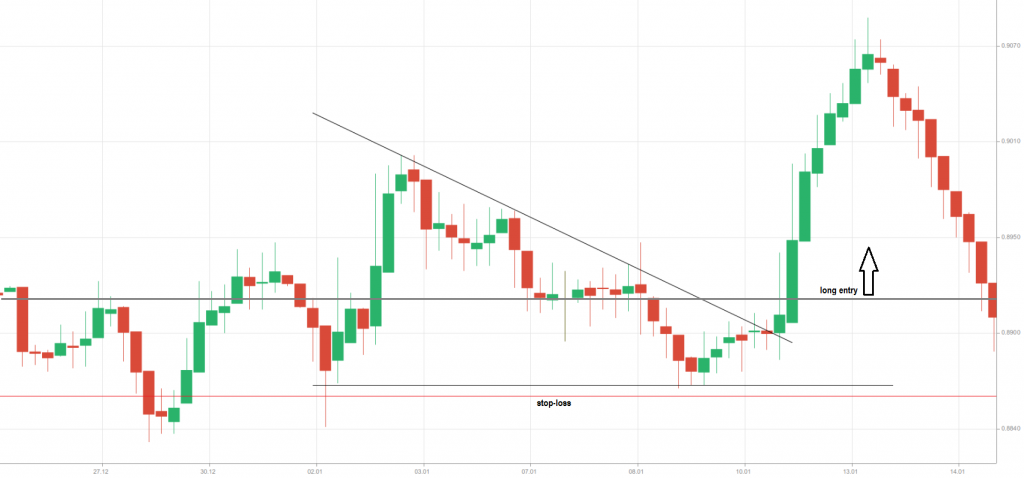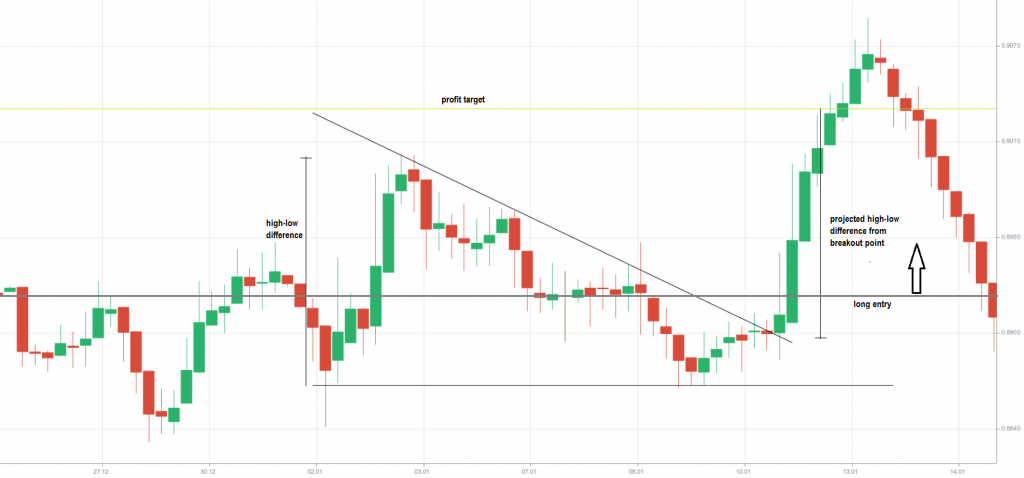Symmetrical, ascending and descending triangles
This lesson will cover the following
- How is a symmetrical triangle formed?
- How is a descending triangle formed?
- How is an ascending triangle formed?
- How to trade triangle formations?
In case a pattern has boundary lines, which are not parallel and if extended into the future they eventually cross each other, this results in a formation, known as a triangle. These formations may occur due to a lower bound with an upward slope or due to an upward bound with a downward slope.
Within a triangle, the point, where the two boundary lines extend and eventually cross each other, is known as an apex. The difference between the first high reversal point and the first low reversal point is known as a base.
Several types of standard triangles can be recognized – symmetrical, ascending and descending.
Symmetrical triangles
These triangles usually have a downward-sloping upper bound and an upward-sloping lower bound, which contributes to the horizontal direction of the patterns. We can say this in another way – prices reach lower highs and higher lows at almost equal pace. Within a symmetrical triangle, both boundary lines appear to have the same angle, but however, directions are different. The area of the triangle itself is usually filled with price action, while prices need to touch each boundary line at least twice.
Symmetrical triangles are often considered as a continuation patterns (suggesting a pause or consolidation in the prior trend), rather than reversal patterns, but however, this is not a strict rule. As highs and lows tend to approach each other and eventually reach an apex, we can say that the direction of the triangle is flat. Therefore, symmetrical triangles may not be properly perceived as patterns, which lead to exhaustion of a prior trend. They are, instead patterns, which lead to consolidation, when market participants are mostly indecisive.
Here we can see a symmetrical triangle with a breakout, occurring to the upside.
Within these triangles price volatility usually diminishes, because, as we said, the distance between highs and lows decreases.
Within these formations long-positioned and short-positioned players could not prevail each other, until eventually the majority of traders become aware of a certain direction. This is when a breakout from the triangle occurs. Some studies on technical analysis have concluded that in 54% of all cases this breakout is upward. However, these types of triangles may show many false breakouts, which urges traders to pay a little more attention and to act with caution.
On the 1-week chart of EUR/USD above we can observe what a reversal symmetrical triangle looks like.
Ascending triangles
These triangles usually have a horizontal upper boundary (resistance line), while their lower bound has an upward slope. We can say this in another way – prices reach higher lows, while the resistance line limits price action until eventually a breakout occurs.
Ascending triangles suggest that long-positioned traders are strong, because price action forms higher lows, while short-positioned players demonstrate a gradually diminishing strength. Despite that sellers manage to force buyers away from the resistance level, each time this occurs with a lesser force. As sellers fail to push buyers back to the same bottoms (troughs), eventually buying pressure increases, with more buyers joining in. This way prices get closer and closer to the resistance line, until they finally breach it.
Although some theories teach that a breakout occurs in the direction of the triangle (an upward breakout in 77% of all cases), it is common to see a breakout in the other direction, in case the line of resistance appears to be too strong for long-positioned traders.
Here we can see an ascending triangle with a breakout, occurring to the downside.
On the 4-hour chart of AUD/USD above we can observe an ascending triangle, reflecting the continuation of the prior downtrend.
Descending triangles
These triangles usually have a horizontal lower boundary (support line), while their upper bound has a downward slope. We can say this in another way – prices form lower highs, while the support line limits price action until eventually a breakout occurs.
Descending triangles suggest that short-positioned traders are strong, because price action forms lower highs, while long-positioned players demonstrate a gradually diminishing strength. Despite that buyers manage to hold sellers offensive and to force them away from the support level, each time this occurs with a lesser force. As buyers fail to push sellers back to the same peaks (highs), eventually selling pressure increases, with more sellers entering into positions. This way prices get closer and closer to the support line, until they finally breach it.
Although some technical anlysis studies have concluded that a breakout occurs in the direction of the triangle (a downward breakout in 64% of all cases), it is common to see a breakout in the other direction, in case the line of support appears to be too strong for short-positioned traders.
Here we can see a descending triangle with a breakout, occurring to the downside.
Here we can see a descending triangle with a breakout, occurring to the upside.
On the 4-hour chart of AUD/USD above we can see a descending triangle, reflecting the continuation of the previous uptrend.
Trading triangles
The best situation to trade triangles is the occurrence of a breakout. The direction of the breakout does not need to be forecast. Traders should act in the direction of the breakout, once it occurs. In case traders have already entered into positions, when the pattern forms, it would be proper if they hold these positions, as the triangle keeps forming.
In case the breakout occurs in the opposite direction compared to the positions, which traders have already taken, these positions would need to be closed. This is so, because a breakout in the opposite direction of their positions would increase their exposure to risk. Price movement against them may be considerable, especially if the breakout signals, that the major trend is reversing.
A breakout occurs, if price action manages to breach one of the bounds of the triangle. When this happens, a trader should enter into a long position, if price action breaks a resistance line, while he/she should enter into a short position, if price action breaks a support line.
In order to protect himself/herself from a false breakout, he/she should wait for a candle to close outside of the pattern itself. However, if a candle closes considerably outside of the pattern, the potential for profit decreases, because the position has been taken too late.
Protective stops are usually placed in a close distance outside the opposite side of the pattern. In case price action breaches the level of support, a trader should enter into a short position, with the stop loss being placed right above the level of resistance. In case price action breaches the level of resistance, a trader should enter into a long position, with the stop loss being placed right beneath the level of support.
On the 4-hour chart of AUD/USD above we show the position of our protective stop, when trading this descending triangle formation.
The profit target, when trading all types of triangles, is measured as follows:
1. A trader needs to subtract the high price from the low price of the triangle, which will result in a positive value. High and low prices are the points, where each boundary (line) begins, but however, this may not always be valid.
2. In case a breakout to the upside occurs, the trader will usually add the positive value (as estimated above) to the price, where the level of resistance has been broken. This way the breakout target is estimated.
3. In case a breakout to the downside occurs, the trader will usually subtract the positive value (as estimated above) from the price, where the level of support has been broken. Again a breakout target is estimated.
On the 4-hour chart of AUD/USD above we show the position of our profit target, when trading this descending triangle pattern.
